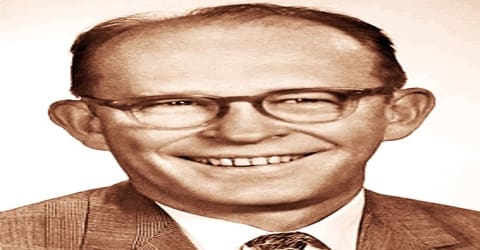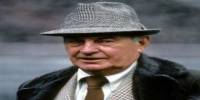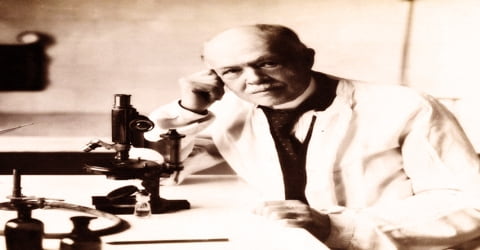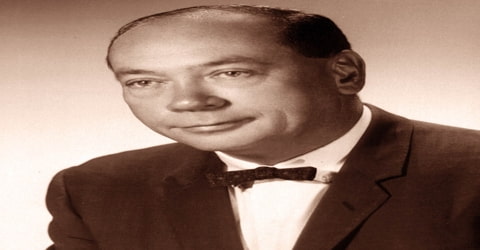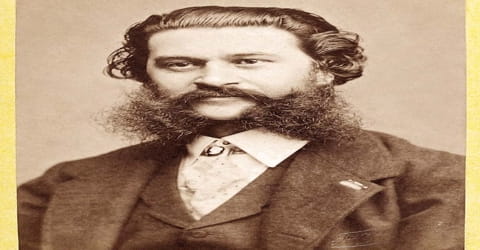Albert Camus – Philosopher, Author, and Journalist (1913-1960)
Full Name: Albert Camus
Date of birth: 7 November 1913
Place of birth: Dréan (then Mondovi), French Algeria
Date of death: 4 January 1960 (aged 46)
Place of death: Villeblevin, France
Alma mater: University of Algiers
Era: 20th century philosophy
Region: Western philosophy
Main interests: Ethics, humanity, justice, politics
Early Life
 (Young Albert Camus)
(Young Albert Camus)
Albert Camus was born on November 7, 1913, in Mondovi, French Algeria. He was a French philosopher, novelist, essayist, and playwright, best known for such novels as L’Étranger (1942; The Stranger), La Peste (1947; The Plague), and La Chute (1956; The Fall) and for his work in leftist causes. He received the 1957 Nobel Prize for Literature.
His views contributed to the rise of the philosophy known as absurdism. He wrote in his essay The Rebel that his whole life was devoted to opposing the philosophy of nihilism while still delving deeply into individual freedom.
Camus did not consider himself to be an existentialist despite usually being classified as a follower of it, even in his lifetime. In a 1945 interview, Camus rejected any ideological associations: “No, I am not an existentialist. Sartre and I are always surprised to see our names linked.”
He was born just before the onset of the First World War to semi-proletariat parents; he lost his father at infancy, and grew up in the house of his maternal grandmother in the working class suburbs of Algiers. At the local Ecole Communale, where he started his education, he was spotted by one of his teachers, who not only convinced his grandmother to allow him to study, but also made sure he got a scholarship. Thus he was able to get admission at the Lycée Bugeaud, where he was mentored by another teacher. Soon he decided to become a teacher and a writer. Unfortunately, it was his recurring tuberculosis, which prevented him from fulfilling the first aim; but he accomplished his second wish early in life and by his mid-twenties, he was able to establish himself as an emerging author, journalist, and theatre professional. However, it took a few more years to become internationally known. He was one of the youngest recipients of the Nobel Prize for Literature, winning it at the age of 44. However, he did not live long after that and died in a road accident at the age of 46.
Camus joined the French Communist Party in early 1935, seeing it as a way to “fight inequalities between Europeans and ‘natives’ in Algeria.” He did not suggest he was a Marxist or that he had read Das Kapital, but did write, “We might see communism as a springboard and asceticism that prepares the ground for more spiritual activities.” In 1936, the independence-minded Algerian Communist Party (PCA) was founded. Camus joined the activities of the Algerian People’s Party (Le Parti du Peuple Algérien), which got him into trouble with his Communist party comrades, who in 1937 denounced him as a Trotskyite and expelled him from the party. Camus then became associated with the French anarchist movement.
The anarchist André Prudhommeaux first introduced him at a meeting in 1948 of the Cercle des Étudiants Anarchistes (Anarchist Student Circle) as a sympathiser familiar with anarchist thought. Camus wrote for anarchist publications such as Le Libertaire, La révolution Proletarienne, and Solidaridad Obrera (Workers’ Solidarity), the organ of the anarcho-syndicalist CNT (National Confederation of Labor). Camus stood with the anarchists when they expressed support for the uprising of 1953 in East Germany. He again allied with the anarchists in 1956, first in support of the workers’ uprising in Poznań, Poland, and then later in the year with the Hungarian Revolution.
Educational Career
In 1918, Camus began his studies at the local Ecole Communale. Very soon he caught the attention of his teacher Louis Germain, who advised him to seek a scholarship so that he could attend secondary school. He also convinced his grandmother to allow him to complete his education.
At school Camus excelled in both studies and sport. He was especially fond of playing football and swimming. More than that, he started enjoying the intellectual challenge the school provided and especially loved reading the works of Gide and Malraux.
In 1923, Camus was accepted into the Lycée Bugeaud (fr) and eventually was admitted to the University of Algiers. After he contracted tuberculosis in 1930, he had to end his football activities; he had been a goalkeeper for a prominent Algerian university team. In addition, he was only able to study part-time. To earn money, he took odd jobs: as a private tutor, car parts clerk, and assistant at the Meteorological Institute.
 (University of Algiers)
(University of Algiers)
In 1932 he received his Baccalauréat degree. The following year, he entered the University of Algiers specializing in philosophy. By now, his old mentor Jean Grenier had joined the philosophy department of the university and therefore, he continued receiving his guidance. Camus also gained certificates in sociology and psychology.
He completed his licence de philosophie (BA) in 1936; in May 1936, he successfully presented his thesis on Plotinus, “Rapports de l’hellénisme et du christianisme à travers les oeuvres de Plotin et de saint Augustin” (“Relationship of Greek and Christian thought in Plotinus and St. Augustine”), for his diplôme d’études supérieures (fr) (roughly equivalent to an MA thesis).
Playing Career
Camus played as goalkeeper for Racing Universitaire d’Alger (RUA won both the North African Champions Cup and the North African Cup twice each in the 1930s) junior team from 1928 to 1930. The sense of team spirit, fraternity, and common purpose appealed to Camus enormously. In match reports Camus would often attract positive comment for playing with passion and courage. Any football ambitions disappeared when he contracted tuberculosis at the age of 17. The affliction, which was then incurable, caused Camus to be bedridden for long and painful periods.
When Camus was asked in the 1950s by an alumni sports magazine for a few words regarding his time with the RUA, his response included the following: “After many years during which I saw many things, what I know most surely about morality and the duty of man I owe to sport and learned it in the RUA.” Camus was referring to a sort of simplistic morality he wrote about in his early essays, the principle of sticking up for your friends, of valuing bravery and fair-play. Camus’s belief was that political and religious authorities try to confuse us with over-complicated moral systems to make things appear more complex than they really are, potentially to serve their own needs.

Camus was once asked by his friend Charles Poncet which he preferred, football or the theatre. Camus is said to have replied, “Football, without hesitation.”
Career
In 1935 he cofounded Théâtre du Travail (Worker’s Theatre) and started writing plays. By now, he had joined the French Communist Party and many of his works carried leftist messages.
He established himself as an emerging author, journalist, and theatre professional. He had by now published his first two works, ‘Betwixt and Between’ (L’envers et l’endroit, 1937), and ‘Nuptials’ (Noes, 1938).
In 1939, Camus was fired from his job because of a report he made on the poor conditions of peasants in Kabylie. He then joined another socialist paper called ‘Soir-Republica’ as a reporter and reviewer. Here his assignments covered everything from contemporary European literature to local political trials.
As he wrote in L’Homme révolté (The Rebel), in the chapter about “The Thought on Midday”, Camus was a follower of the ancient Greek ‘Solar Tradition’ (la pensée solaire). In 1947–48, he founded the Revolutionary Union Movement (Groupes de liaison internationale – GLI) a trade union movement in the context of revolutionary syndicalism (Syndicalisme révolutionnaire).
In 1940, he gave up the job, intending to serve in the Second World War, but was rejected by the French army because of his tuberculosis. So he left for Paris in March 1940 and began working as an editorial secretary on ‘Paris-Soir.’ However, he did not like Paris.

From 1943, Albert Camus had correspondence with Altiero Spinelli who founded the European Federalist Movement in Milan—see Ventotene Manifesto and the book “Unire l’Europa, superare gli stati”, Altiero Spinelli nel Partito d’Azione del Nord Italia e in Francia dal 1944 al 1945-annexed a letter by Altiero Spinelli to Albert Camus.
In 1944, Camus founded the “French Committee for the European Federation” (Comité Français pour la Féderation Européenne – CFFE) declaring that Europe “can only evolve along the path of economic progress, democracy and peace if the nation states become a federation.”
From 22 to 25 March 1945, the first conference of the European Federalist Movement was organised in Paris with the participation of Albert Camus, George Orwell, Emmanuel Mounier, Lewis Mumford, André Philip, Daniel Mayer, François Bondy and Altiero Spinelli. This specific branch of the European Federalist Movement disintegrated in 1957 after Winston Churchill’s ideas about European integration rose to dominance.
During the war Camus joined the French Resistance cell Combat, which published an underground newspaper of the same name. This group worked against the Nazis, and in it Camus assumed the nom de guerre Beauchard. Camus became the paper’s editor in 1943. He first met Sartre at the dress rehearsal of Sartre’s play, The Flies, in June 1943.
He resigned from Combat in 1947 when it became a commercial paper. After the war, Camus began frequenting the Café de Flore on the Boulevard Saint-Germain in Paris with Sartre and others. He also toured the United States to lecture about French thought.
In 1949, his tuberculosis returned, whereupon he lived in seclusion for two years. In 1951, he published The Rebel, a philosophical analysis of rebellion and revolution which expressed his rejection of communism. Upsetting many of his colleagues and contemporaries in France, the book brought about the final split with Sartre. The dour reception depressed Camus; he began to translate plays.
In it, he explicitly condemned Marxism-Leninism and denounced its unrestrained violence as a means of human liberation. While the European communists branded him as reactionary, many more hailed him as an outspoken champion of individual freedom.
In the 1950s, Camus devoted his efforts to human rights. In 1952, he resigned from his work for UNESCO when the UN accepted Spain as a member under the leadership of General Franco. In 1953, he criticized Soviet methods to crush a workers’ strike in East Berlin. In 1956, he protested against similar methods in Poland (protests in Poznań) and the Soviet repression of the Hungarian revolution in October.
From 1955 to 1956, Camus wrote for L’Express. In 1957, he was awarded the Nobel Prize in literature “for his important literary production, which with clear-sighted earnestness illuminates the problems of the human conscience in our times”.
He published many short stories and essays. He also wrote, directed and produced number of plays. ‘Les Possédés’ (The Possessed, 1959), adapted from Fyodor Dostoyevsky’s novel ‘Demons’, was probably his last published work while alive.
In the 1930s, Camus was affiliated with Left-wing groups like the Maison de Culture in Algiers which were highly critical of the French colonial regime’s treatment of Algeria’s Arab and indigenous inhabitants, supporting the Blum-Violette proposal to grant Algerians full French citizenship.

In 1945, following the Sétif and Guelma massacre after Arab revolts against French mistreatment, Camus was one of only a few mainland journalists to visit the colony, again writing a series of article reports on conditions, and advocating for French concessions and reforms to the demands of the Algerian people.
When the Algerian War began in 1954, Camus was confronted with a moral dilemma. He identified with the Pieds-Noirs such as his own parents and defended the French government’s actions against the revolt. He argued that the Algerian uprising was an integral part of the ‘new Arab imperialism’ led by Egypt and an ‘anti-Western’ offensive orchestrated by Russia to ‘encircle Europe’ and ‘isolate the United States’.
Camus regretted the continued reference to himself as a “philosopher of the absurd”. He showed less interest in the Absurd shortly after publishing Le Mythe de Sisyphe (The Myth of Sisyphus). To distinguish his ideas, scholars sometimes refer to the Paradox of the Absurd, when referring to “Camus’ Absurd”.
His early thoughts appeared in his first collection of essays, L’Envers et l’endroit (Betwixt and Between) in 1937. Absurd themes were expressed with more sophistication in his second collection of essays, Noces (Nuptials), in 1938. In these essays Camus reflects on the experience of the Absurd. In 1942 he published the story of a man living an absurd life as L’Étranger (The Stranger). In the same year he released Le Mythe de Sisyphe (The Myth of Sisyphus), a literary essay on the Absurd. He also wrote a play about Caligula, a Roman Emperor, pursuing an absurd logic. The play was not performed until 1945.
Throughout his life, Camus spoke out against and actively opposed totalitarianism in its many forms. Early on, Camus was active within the French Resistance to the German occupation of France during World War II, even directing the famous Resistance journal, Combat. On the French collaboration with Nazi occupiers he wrote: “Now the only moral value is courage, which is useful here for judging the puppets and chatterboxes who pretend to speak in the name of the people.” After liberation, Camus remarked, “This country does not need a Talleyrand, but a Saint-Just.”
One further important, often neglected component of Camus’ philosophical and literary persona was his love of classical Greek thought and literature, or philhellenism. This love looks back to his youthful encounters with Nietzsche, his teacher Jean Grenier, and his own sense of a “Mediterranean” identity, based in a common experience of sunshine, beaches, and living in proximity to the near-Eastern world.
Personal Life
Albert Camus was born on 7 November 1913 in Dréan (then known as Mondovi) in French Algeria. His mother was of Spanish descent and could only hear out of her left ear. His father, Lucien, a poor agricultural worker of Alsatian descent. Albert lived with his father for just eight months, until the outbreak of World War I. Lucien was called up and was among the first to be wounded in the Battle of Marne. He died of his wounds on October 11th 1914.
Camus and his mother, an illiterate house cleaner, lived without many basic material possessions during his childhood in the Belcourt section of Algiers.
In 1923, Camus was enrolled at the Lycée Bugeaud, where boys from different backgrounds came to study. While filling the form, he was initially embarrassed to write his mother’s occupation as ‘domestic,’ but soon became angry with himself. After that he was never ashamed of his poverty.
On June 16, 1934 Camus married Simone Hié, who was earlier engaged to Camus’ friend Max-Pol Fouchet. However, the marriage did not last long and they separated by July 1936 and the divorce was finalized in September 1940.
 (Max-Pol Fouchet)
(Max-Pol Fouchet)
On 3 December 1940, Camus married Francine Faure, a pianist and mathematician, whom he had met in 1937. Although he loved his wife, he did not believe in the institution of marriage and had many extra martial affairs. In spite of that, the couple had twin daughters Catherine and Jean, born on 5 September 1945.

Camus had numerous affairs, particularly an irregular and eventually public affair with the Spanish-born actress María Casares. In the same year, Camus began to work for Paris-Soir magazine. In the first stage of World War II, during the so-called Phoney War, Camus was a pacifist. While in Lyon during the Wehrmacht occupation, on 15 December 1941, Camus read about the Paris execution of Gabriel Péri; it crystallized his revolt against the Germans.
He moved to Bordeaux with the rest of the staff of Paris-Soir. In the same year he finished his first books, The Stranger and The Myth of Sisyphus. He returned briefly to Oran, Algeria, in 1942.
Death
Camus died in a car accident near Sens, in Le Grand Fossard in the small town of Villeblevin on 4 January 1960, at the age of 46. Although many suggested that the accident was orchestrated by the Soviets, there is no proof of that. Camus was survived by his wife and daughters.

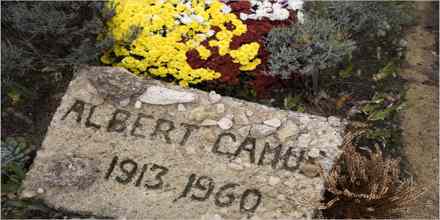
The driver of the Facel Vega HK500 car, Michel Gallimard, who was Camus’s publisher and close friend, also died in the accident. In August 2011, the Milan newspaper Corriere della Sera reported a theory that the writer had been the victim of a Soviet plot, but Camus’s biographer, Olivier Todd, did not consider it credible. Camus was buried in the Lourmarin Cemetery, Lourmarin, Vaucluse, France.
Two of Camus’s works were published posthumously. The first, entitled A Happy Death (1970), featured a character named Patrice Mersault, comparable to The Stranger’s Meursault.
There is scholarly debate as to the relationship between the two books. The second was an unfinished novel, The First Man (1995), which Camus was writing before he died. The novel was an autobiographical work about his childhood in Algeria.
Honours
In 1957, Camus was awarded the Nobel Prize in Literature “for his important literary production, which with clear-sighted earnestness illuminates the problems of the human conscience in our times”.
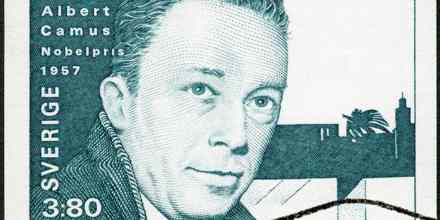
Some of His Famous Novels, Stories, Plays and Essays Books
Novels
- The Stranger (1942)
- The Plague (La Peste) (1947)
- The Fall (La Chute) (1956)
- A Happy Death (written 1936–38, published posthumously 1971)
- The First Man (incomplete, published posthumously 1995)
Short stories
- Exile and the Kingdom
- The Adulterous Woman
- The Renegade or a Confused Spirit
- The Silent Men
- The Guest
- Jonas or the Artist at Work
- The Growing Stone
Non-fiction books
- Christian Metaphysics and Neoplatonism (1935)
- Betwixt and Between (collection, 1937)
- Nuptials (Noces) (1938)
- The Myth of Sisyphus (1942)
- The Rebel (1951)
- Notebooks 1935–1942 (1962)
- Notebooks 1943–1951 (1965)
- Notebooks 1951–1959 (2008)
- Algerian Chronicles (2013)
Plays
- Caligula (performed 1945, written 1938)
- Requiem for a Nun (1956)
- The Misunderstanding (1944)
- The State of Siege (1948)
- The Just Assassins (1949)
- The Possessed (1959)
Essays
- Create Dangerously (Essay on Realism and Artistic Creation) (1957)
- The Ancient Greek Tragedy (Parnassos lecture in Greece) (1956)
- The Crisis of Man (Lecture at Columbia University) (1946)
- Why Spain? (Essay for the theatrical play L’ Etat de Siège) (1948)
- Reflections on the Guillotine (Extended essay, 1957)
- Neither Victims Nor Executioners (1946)

